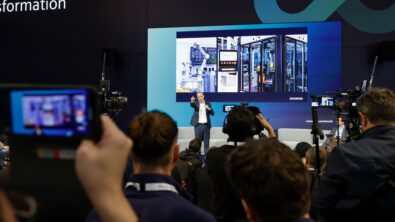Meet the “Strati”, the first #3DPrintedCar and proof point for the Digital Manufacturing Revolution
Every now and then you get to witness a historic moment. Last week was one of those occasions for me when I was able to witness the official birth of the first 3D-printed car, the “Strati” at the International Manufacturing Technology Show (IMTS).
The Strati (or “layers” in Italian) is the result of a cooperation of Local Motors with the Association for Manufacturing Technology (AMT) and its Oak Ridge National Labs (ORNL), as well as Cincinnati Incorporated, and many other providers, including Siemens as a technology partner on the CAD side with Solid Edge. The Strati was designed by Michele Anoe of Italy in a Local Motors design challenge that was launched in April, so only a few months ago. You can see a lot of the core team members and the finished Strati here at the IMTS show:
Local Motors and their co-founder/CEO Jay Rogers have been an “open source hardware innovator” and a real manufacturing pioneer since 2007. Today Local Motors have approximately 80 employees and over 46,000 community members, collaborating on 6,000 designs and over 2,000 ideas across 40 projects. Their new logo ‘born different’” really expresses their continued drive to innovate and change the way we all think about creating and making things. To prove out their vision, Jay and team picked the vehicular/automotive space, and who can argue with automotive being both fun and very real in terms of its manufacturing challenges?
Here is a simplified overview of the Strati’s design and creation process:

Critics may argue that the Strati is not yet at the level of a typical serial production car, but as far as I am concerned they are missing the point. The Strati was a challenge on multiple levels, and the fact that Local Motors and their partners were able to design and make the car in only a few months (the challenge was launched in April, and they printed the car at IMTS in September, so less than 6 months) shows the potential of this new process and of completely changing the way things are made and brought to market. A few of these key process improvements with disruptive potential include:
• A new, highly flexible “design to make” innovation process: Local Motors can essentially take any type of design and use the same process to make an entirely new car.
• The ability to efficiently make a car: The Strati is made without specialized tooling, which is usually a key cost driver in the automotive manufacturing process. This opens up new possibilities for mass customization as opposed to just mass production of more or less the same type of product.
• Simplifying the supply chain: One of the key drivers of complexity today in the manufacturing process is the vast supply chain of parts and partners required. The Strati dramatically cuts down on the number of parts (see box below).
• Collaboration: The project brought technology partners together and both physically and digitally connected them in a way that enabled an end to end process.
• It also tapped into the innovation potential of a vast community pool of creative designers and experts.

All of these benefits and the innovation process Local Motors employed are certainly not uniquely limited to car manufacturing, or the vehicular space. Think of other consumer goods that could benefit from the same process, for example kitchenware, toys, furniture, even medical equipment. Already, more serious applications for 3D-printing are finding their way into the Aerospace industry. The important thing here is not to look at the limitations of the current Strati, but rather at what it stands for and all the opportunities it represents.
Certainly, the first computers were nothing close to the digital devices and smartphones we all carry and use today. The Strati and Local Motors above all represent a symbol of what Digital Manufacturing can offer us in the future:
• New ways do drive innovation… and products that are personal and exciting
• Leveraging information and partnerships in new ways to create products more efficiently, and
• An ability to fail quickly at much lower cost, which in turn can fuel additional innovation.
One of the key ingredients to success was Local Motors’ ability to bring together a great group of companies and partners. They set a tough challenge and found the right group of people to meet that challenge. There are way too many partners to list them all here, but Cincinnati Incorporated (CINCINNATI), for example, created a special machine, the BAAM (which stands for Big Area Additive Manufacturing, see picture below), which allowed them to do large-scale additive printing at the scale required for the Strati at IMTS. In fact, CINCINNATI in conjunction with Oak Ridge National Laboratory has designed and constructed a machine that is 10 times bigger and 200 times faster at 3-D printing in thermoplastics than other machines on the market. CINCINNATI used Solid Edge to rapidly modify the design on one of their laser cutting systems to make BAAM. Typical product development in the machine tool business takes years, but CINCINNATI was able to put a machine on the IMTS trade show floor 7 months after Local Motors presented them with the challenge. The BAAM is similar to fused deposition modeling printers (FDMs) by taking a 6.5’ x 13’ foot laser cutter and transforming it into a massive 3D printer. In addition to plastic, the BAAM at IMTS used about 15% carbon fiber, which makes for very robust material, while still allowing it to be printed at reasonable temperatures in a show environment. CINCINNATI has demonstrated that the STL file output from Solid Edge can rapidly be converted to the G-Code needed to drive the machine.

Siemens has been partnering with Local Motors since 2011, mainly by providing software and support for 3D CAD (Computer Aided Design) with Siemens’ Solid Edge design productivity platform. Solid Edge with synchronous technology allowed Local Motors to quickly make design changes and iterations that could be taken straight to the 3D printing process with STL files. Solid Edge was also integral in preparing the Strati for 3D printing, regardless of the source of data. The mechanical component parts for the Strati were leveraged from the Renault Twizy and the design files were not initially integrated with the design of the 3D printed portion of the car, so virtually all of the components had to be redesigned to fit onto the new “chassis”. Solid Edge provided the answer, because the component parts could be easily imported and modified to design the intermediate structures that would reliably mount to the ABS/Carbon material extruded by the 3D printer.
There is a reason that Local Motors’ project name for the #3Dprintedcar, is DDM: Direct to Digital Manufacturing. While the transitions between the tools, CAD, 3D Printing, Machining, etc. can still be improved, the ability to digitally drive the process from concept to finish is a clear enabler for the type of collaboration required here.
Now, certainly, there are still plenty of challenges with the current process: For example, the finishing of the car is not what consumers will expect from a regular production vehicle. There are going to be safety and quality questions that need to be answered. Also, the assembly process is still very manual. Local Motors report that they have plans to address those challenges going forward, including robots in the process in order to automate assembly, or adding automated inspection tools (some were on display at IMTS.).
More than getting it perfect right away, this was the birth of a new paradigm in a highly visible space that we all love: Cars! And maybe not unlike Moore’s law, we can expect the innovation cycles for Direct to Digital Manufacturing to keep pushing out significant advances, from Local Motors, Oak Ridge National Labs, but also others in this space, such as the Digital Manufacturing & Design Innovation Institute, an initiative of UI LABS.
The next chapter: Local Motors say that following IMTS 2014, AMT (the Association for Manufacturing Technology) will seek other collaborative opportunities with forward-thinking companies to realize the full potential of Direct Digital Manufacturing (DDM) in sustainable, nontraditional manufacturing projects.
If nothing else, Jay and Local Motors continue to inspire us and demonstrate that Manufacturing in America is an exciting field that has a bright future, powered by the Digital Manufacturing revolution!
Maybe you also have some stories about how Digital Manufacturing is opening up entirely new opportunities? If so, drop me a comment. I would love to hear about them.
Disclaimers, credits and further reading:
– This blog and all opinions are my own. I tried to identify all my sources and input below.
– To watch the making of the Strati, click here for a 45-second time-lapse video
– Sources and press/media links:
o Local Motors
o A short CNN video about the car is here
o AutomotiveTimes.com
o DesignersofThings
o TheCoolList.com
o More information about the DMDII initiatives of UI LABS here





